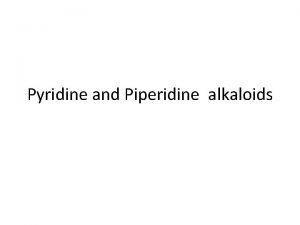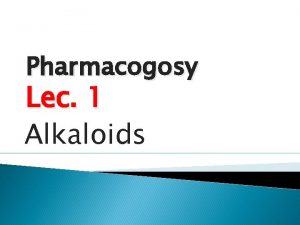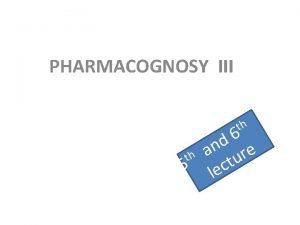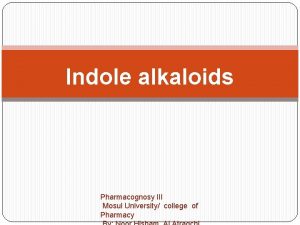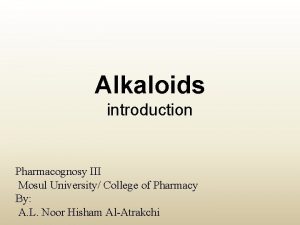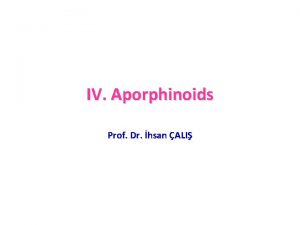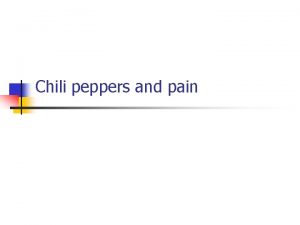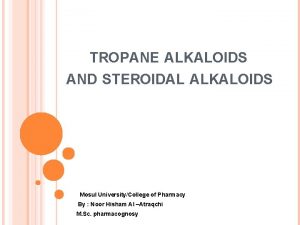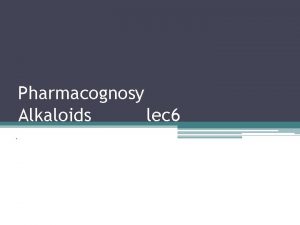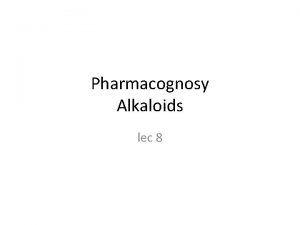Alkaloids Structure and classification of alkaloids 1 Phenylethyl












- Slides: 12

Alkaloids • • • Structure and classification of alkaloids (1) Phenylethyl amine alkaloids (2) Pyrrolidine alkaloids (3) Pyridine or piperidine alkaloids (4) Pyridine pyrrolidine alkaloids (5) Tropane alkaloids (6) Quinoline alkaloids (7) Isoquinoline alkaloids (8) Phenanthrene alkaloids (9) Indole alkaloids (10) Tropolone alkaloids

Basic nuclei of alkaloids


Isolation of alkaloids

Structure-elucidation of alkaloids • 1 The first step in determining the structure of a pure alkaloid consists in ascertaining its molecular formula and optical rotatory power. • 2 The presence of unsaturation in an alkaloid may ascertained by the addition of bromine or halogen acids or by hydroxylation with dilute alkaline permanganate. • 3 Frequently an alkaloid is cleaved into simple fragments by hydrolysis with water, acid or alkali and the fragments so obtained are examined separately since the structure of the fragment may easily be established than that of the whole molecule. • 4 The next step involves in ascertaining the functional nature of oxygen and nitrogen atoms either in the molecule itself or in its fragments obtained by hydrolysis as in step 2. • 5 Functional nature of oxygen: The oxygen atom may be present in the form of alcoholic or phenolic hydroxyl ( OH), methoxyl ( OCH 3), acetoxyl re OCOCH 3), benzoxyl ( COC 6 H 5), carboxyl ( COOH) or carbonyl (C=O) group, various oxygen functional groups can be characterized according to the following characteristics

• (i) Phenolic hydroxyl group (=C-OH) : The phenolic hydroxyl group is characterized by alkali solubility followed by reprecipitation by carbon dioxide, a colour reaction with ferric chloride, acylation to an ester and alkylation to an ether. The number of phenolic hydroxyl groups is estimated by acetylation. • (i) Alcoholic hydroxyl group (-C-OH) : The alcoholic hydroxyl group is generally indicated by its acylation reaction along with the negative tests for phenolic group. It is further confirmed by characteristics like dehydration, oxidation, and absorption spectrum in the infrared. The three possible alcoholic groups are usually differentiated by their oxidation reactions. • (iii) Carboxyl group (-COOH) : The carboxyl group is indicated by its solubility in weak bases, like Na. HCO 3, NH 3, etc. , esterification with alcohols, and specific absorption in the infrared. The groups are generally estimated quantitatively either by acid alkali titration or by silver salt method.

• (IV) Alkoxyl group (-OR) : The alkoxyl groups, generally methoxy ( OCH 3) and sometimes ethoxy ( OC 2 H 5) occur frequently in the alkaloids. It is detected as well as estimated by Zeisel method which involves boiling of the alkaloid with concentrated hydriodic acid at its boiling point (126 o. C) when the alkoxy groups are converted into alkyl halides which can be easily estimated as silver iodide by treatment with ethanolic silver nitrate.

The number of moles of silver iodide is equivalent to the number of alkoxyl groups in the alkaloid. The related group, methylenedioxy ( O CH 2 O ) is estimated on the basis that it librates formaldehyde when treated with hydrochloric or sulphuric acid; thus the quantitative estimation of formaldehyde will give the number of methylenedioxy groups.

• The number of moles of silver iodide is equivalent to the number of alkoxyl groups in the alkaloid. • The related group, methylenedioxy ( O CH 2 O ) is estimated on the basis that it librates formaldehyde when treated with hydrochloric or sulphuric acid; thus the quantitative estimation of formaldehyde will give the number of methylenedioxy groups. • (vi) Ester groups (-OCOR) : Esters (such as OCOCH 3, OCOC 6 H 5) and related groups like amide, lactone, and lactam are detected by their hydrolysis with water, dilute acids, alkali to hydroxyl and acidic compounds. The nature is established by knowing the nature of the acid.


• functional nature of nitrogen • The N alkyl groups are frequently estimated by Herzig Meyer method

• Estimation of C methyl groups
